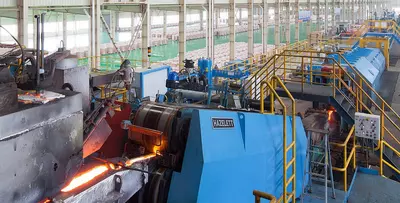The switch to hydrogen-based production is a major factor in reducing CO2 emissions in copper wire rod production. However, it is not only the use of hydrogen as combustion gas in the shaft melting furnace that contributes to the decarbonization; the new electrically operated melting furnaces are also part of the overall strategy. Induction furnaces of different performance classes are available for this purpose.
Finally, digitalization solutions from SMS group create in-depth transparency of processes and energy consumption. The tools allow the casting and rolling processes to be monitored not only in real time, but also to be analyzed in detail so that optimization potentials can be quickly identified and implemented.
Positive outlook: Copper market is growing
Copper plays a central role in the global transformation toward sustainable energy production. In view of the worldwide decarbonization targets, copper demand is forecast to double from the current 25 million tons per year to around 50 million tons per year by 2035. Here, ETP (electrolytic-tough pitch) copper wire rod, which accounts for more than half of the copper products, is an essential semi-finished product for the electrical industry. The diversification and decentralization of electricity generation methods by renewable energies significantly increase the demand for electrical conductors compared to traditional power plants. At the same time, the plans to switch from internal combustion engines to electric vehicles are also pushing the demand for copper. In addition to the vehicles themselves, the associated charging infrastructure also requires extensive use of copper conductors in e-mobility. The forecast doubling of copper demand in the next decade illustrates the growth dynamics and the resulting opportunities for the industry. With the CONTIROD® plants, SMS group ensures that the industry can meet these requirements and actively contribute to sustainability itself.
Forward-looking hydrogen-ready technology for wire rod production
In its CONTIROD® plants, SMS group relies on a highly developed shaft furnace technology that is characterized by its thermal efficiency and, more recently, also by the possibility of using hydrogen. This is becoming all the more urgent as almost all industrialized countries have legislation to regulate CO2 emissions or introduce CO2 certificates, the prices of which will rise significantly in the near future.
A key to solving this challenge is the innovative gas burner from SMS group for shaft furnace plants. This burner is designed in such a way that by admixing hydrogen it not only improves the off-gas values but also reduces the natural gas consumption. The use of hydrogen reduces CO2 emissions without incurring the risk of copper contamination. In addition, new measuring techniques for gas and air allow precise adjustment of the burner power, which also results in optimized combustion. The new burner also contributes to a longer service life and lower maintenance costs. Customers thus benefit not only from ecological but also from considerable economic advantages for new plants and existing plants.
At present, every ton of copper wire rod produced produces emissions of around 70 kg CO2 when 100% natural gas is burned. This figure represents the need for action in the industry, which is actively addressed. In ongoing projects, SMS group experts show ways to reduce overall energy consumption and reduce CO2 emissions on economic terms. The decarbonization of integrated wire rod plants is therefore not only a response to regulatory requirements but also a self-committed step toward an environmentally conscious industry. Together with the customers, we wish to promote the transformation to sustainable copper production.
Small parts, great effect
In addition to decarbonization technology, there is a whole series of new components which are used for new plants and which are also suitable for modernization and revamping. All solutions are characterized by their sustainability and efficiency. Examples of this are the flow-optimized air knife, which is manufactured using the 3D printing process, and the lamella separators, which do not require any nonwovens (filter fleece) during filtering.
A new air wiper system can be used at the end of the cooling section, which has also been optimized. Thanks to the additive manufacturing process, the nozzle has been designed to be flow-optimized. This optimization enables more precise and effective control of the air flow, which significantly reduces the consumption of compressed air.
In the rolling process, various fluids are used for lubricants, cooling and corrosion protection. To ensure that these media are returned to the production cycle, it is necessary to filter out the smallest oxide particles. This particle filtration is crucial for both reducing the abrasion at the rolls and preventing contamination of the final product. The new lamella separators from SMS group offer considerable advantages here, as they work with a reliable technology that completely dispenses with consumables such as filter nonwovens. This saves operating and maintenance costs and helps to conserve resources.
CONTIROD® is a registered trademark of Aurubis Belgium
